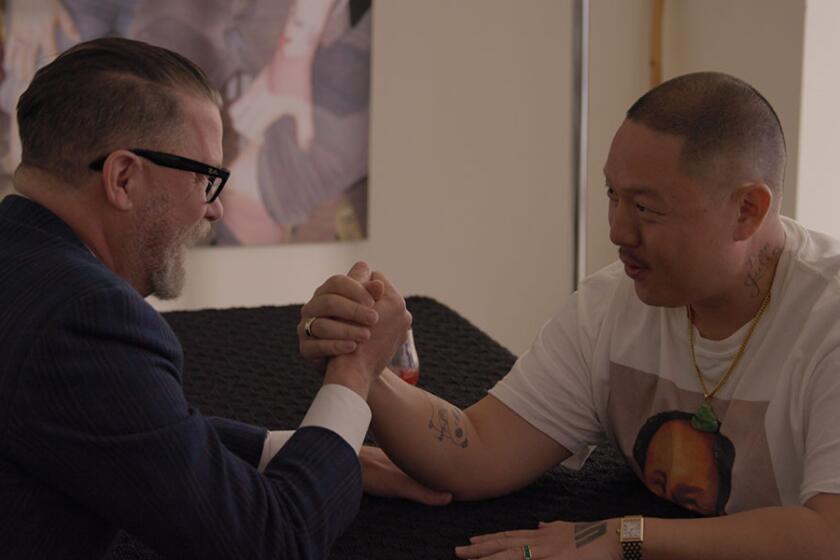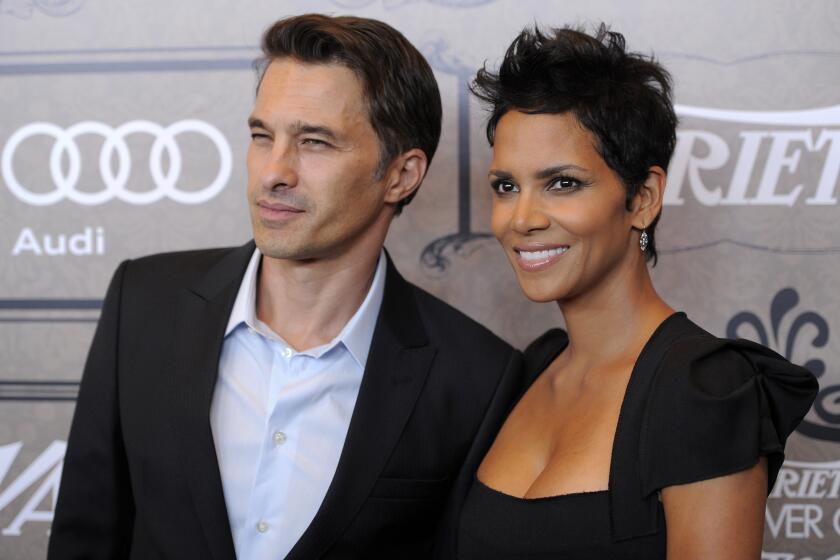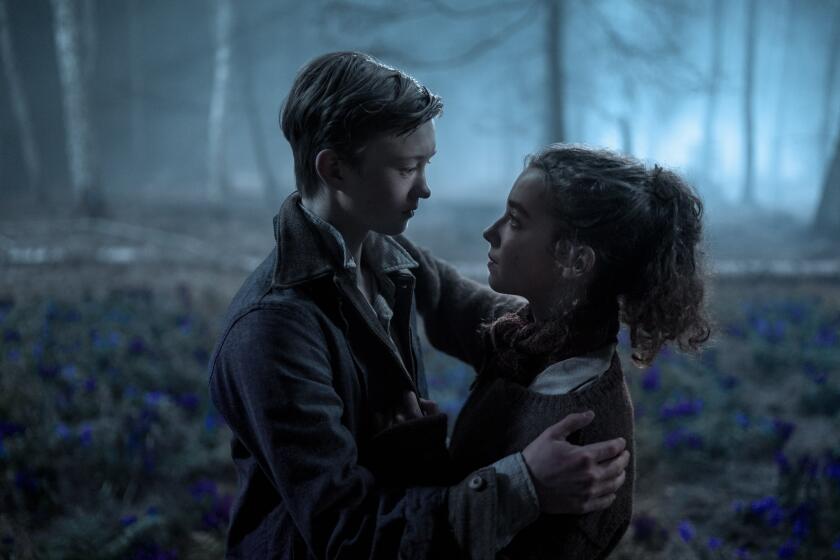History and comedy collide with Aubrey Plaza, Alison Brie and Dave Franco in ‘The Little Hours’
A title card announces the year as 1347 as a young woman in a nun’s habit leads a donkey across an idyllic countryside. She passes through one verdant glen after another on her way back to a small convent, and when she and her sister nuns eventually speak, it is in a pitched contemporary upspeak. Contemporary to now, not then.
Writer-director Jeff Baena’s “The Little Hours” is making its world premiere Thursday as part of the Midnight section at the 2017 Sundance Film Festival. Adapted from stories drawn from Giovanni Boccaccio’s medieval book “The Decameron,” the film draws humor from the tension between its setting and the way the characters speak and interact as a story unfolds about a fugitive servant (Dave Franco) who pretends to be a deaf-mute to be taken in by a convent that includes three young nuns (Aubrey Plaza, Alison Brie, Kate Micucci), each dealing with personal crises of their own.
The film has quite a cast, as it also includes John C. Reilly, Molly Shannon, Nick Offerman, Adam Pally, Fred Armisen, Paul Reiser, Lauren Weedman, Jemima Kirk and Paul Weitz.
SIGN UP for the free Indie Focus movies newsletter »
This is Baena’s third film to make it into Sundance, following the zombie rom-com “Life After Beth” and the sad bachelor party comedy “Joshy.” The new film was shot in Tuscany, Italy, in spring 2016, with the beautiful locations serving as both a selling point for the cast and also something of a scheduling challenge to get everyone there. Ahead of the film’s festival premiere, Baena sat down for an interview about his unusual approach to comedy and making an ahistorical period comedy.
This is your third film and all three have gotten into Sundance. Do you still get nervous about your first screening?
Oh, I still have that. You just don’t know. You show a movie to your friends when you’re working on it, but you don’t have any real objectivity. You just don’t know. So that moment when it’s shown for the very first time at Sundance, it’s just terrifying. I’m so anxious. And then every screening is different.
Your three films are so outwardly different from one another, but do you relate to them in the same way? Is there some secret through-line that links them?
There’s definitely a secret through-line between the three of them, but I think the stuff that people would probably pick up on, it’s not that. That’s probably just more my sensibility and I guess my weird tonal shifts and sense of humor. But these three movies definitely are connected. I almost think of them as a trilogy, even though they are so far off from each other.
There’s references to each other, but they’re very subtle. It’s not meant to be a puzzle; it’s not like “Westworld” or something, but it’s coming from somewhere inside of me. I think ultimately there is a similarity in the dryness of tone of them. I mean, “Life After Beth” is a zombie movie, “Joshy” is a guys-hanging-out movie, and this one is a medieval convent sex comedy. But there’s definitely some underlying connective tissue.
All three are not what they appear to be on first glance. There’s always a sleight of hand going on where they are also something else.
Well, I approach them not just as a creator but also as a viewer of movies. And I try not to do something that you feel comfortable with, so that if you have an obvious choice, as a way of getting from point A to point B, sometimes I just like to forgo that and forget about even trying to get to point B and just see where it goes. If it feels like you’re aiming for something too familiar and you’re not having a primary new experience, then what’s the point of making that movie? It’s been done before, so try to find something new out of it. But I also want to be sure it tracks on a psychic, emotional, spiritual level all at the same time.
From its very first moments, there is this great tension and comedy between the period setting and historical Italian locations and the very contemporary way the characters talk to each other. It never stops being funny.
First off, when you’re shooting in that part of the world, in Tuscany, no matter what you’re shooting it’s gorgeous. I haven’t really had the opportunity because of budget and time to explore the more cinematic elements of filmmaking. I’m just trying to get an exposure and make my day. This one, it was still kind of hectic, but I made a real effort to highlight the more visual aspects of it.
With this movie in particular, it’s based off the source material of “Decameron” by Boccaccio, and when people are given this book that’s really thick like “War and Peace” or “Gravity’s Rainbow,” people are annoyed, like, “I’m going to have to read all this?” But it’s so funny and it’s so contemporary and modern and human and relatable. So I think part of me wanted to play off of that. I didn’t want something that was abstract, portraying the people as automatons who just followed the church. People were really complex and led really rich lives. They’re just like us, they’re just from a different time.
I guess one through-line between the three movies is a sadness and loss. For me, this one there’s a bittersweet connection I’ve built to these people, even though they’ve been dead for 600 years. They were living just like we are. Obviously their world was in medieval Tuscany, so they didn’t have technology and scientific advancement, but their emotionality was identical. And I think we sort of do a disservice when we approach history as something that’s like a lesson or something that exists only in a book. It’s all just people; it’s all politics and interpersonal dynamics.
So aside from the way the characters talk to one another, were you still aiming for historical accuracy in the clothing and details?
Completely. I felt like the trick in this movie was to make everything completely period, historically accurate, and then just make the human beings feel like they’re contemporary. Part of the logic of that was, let’s say we’re doing a documentary on nuns in medieval Italy in 1347, they’d be talking Italian. They wouldn’t be speaking English, they wouldn’t be speaking English with a British accent, it would just be communication and it would feel natural for their time period. So my thinking was let’s cut out that buffer between us and history and just have them talk naturally so it’s one less generation away from feeling separate from this thing. The ultimate version of this movie is going to be when it’s released in Italy and they retranslate and dub it into Italian and they’re just speaking contemporary Italian because that’s what it would feel like back then.
Follow on Twitter: @IndieFocus
ALSO
First look at ‘Golden Exits’ with Jason Schwartzman, Chloe Sevigny and Beastie Boys’ Adam Horovitz
Palm Springs International Film Festival opens new worlds for audiences and filmmakers
When the world feels dangerous, films showing the human experience are key, directors say
More to Read
Only good movies
Get the Indie Focus newsletter, Mark Olsen's weekly guide to the world of cinema.
You may occasionally receive promotional content from the Los Angeles Times.











